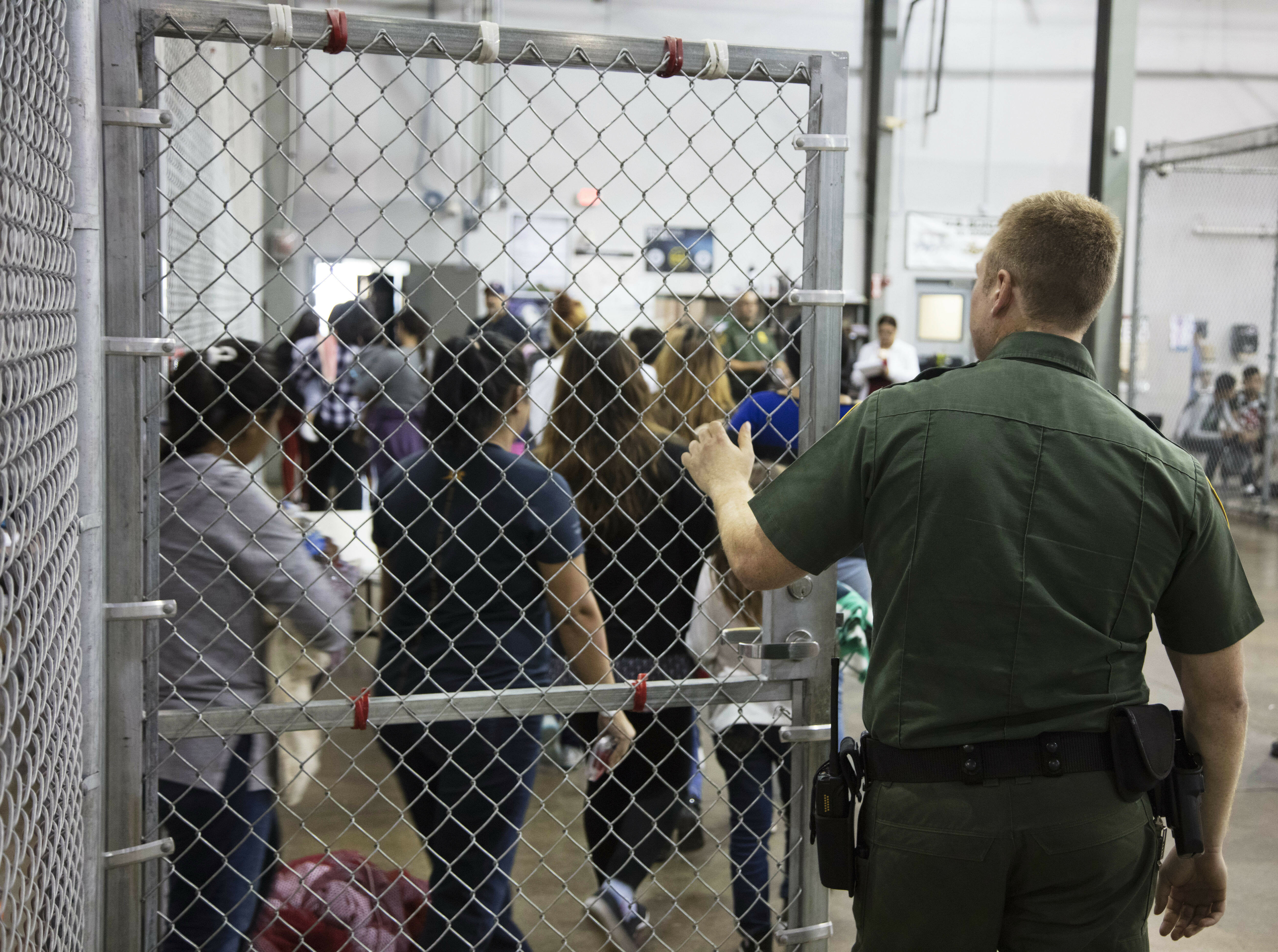Human Zoos in the Age of Trump
The president’s furious contemporary rants and rallies, along with the cages for immigrants, have certainly brought Nazism to mind, but it might be more illuminating to think of them as echoing an earlier moment in history. Associated Press
Associated Press
When Donald Trump recently accused “illegal immigrants” of wanting to “pour into and infest our country,” there was an immediate outcry. After all, that verb, infest, had been used by the Nazis as a way of dehumanizing Jews and communists as rats, vermin, or insects that needed to be eradicated.
Nobody, however, should have been surprised. The president has a long history of excoriating people of color as animal-like. In 1989, for instance, reacting to the rape of a white woman in New York’s Central Park, he took out full-page ads in four of the city’s major papers (total cost: $85,000) calling for the reinstatement of the death penalty and decrying “roving bands of wild criminals roaming our streets.” He was, of course, referring to the five black and Latino youngsters accused of that crime for which they were convicted — and, 10 years late, exonerated when a serial rapist and murderer finally confessed.
Trump never apologized for his rush to judgment or his hate-filled opinions, which eventually became the template for his attacks on immigrants during the 2016 election campaign and for his presidency. He has declared many times that some people aren’t actually human beings at all but animals, pointing, in particular, to MS-13 gang members. At a rally in Tennessee at the end of May, he doubled down on this sort of invective, goading a frenzied crowd to enthusiastically shout that word — “Animals!” — back. In that way, he made those present accomplices to his bigotry. Nor are his insults and racial tirades mere rhetorical flourishes. They’ve had quite real consequences. It’s enough to look at the cages where undocumented children separated from their families at or near the U.S.-Mexico border have been held as if they were indeed animals — reporters and others regularly described one of those detention areas as being like a “zoo” or a “kennel” — not to mention their parents who are also trapped behind wire barriers, even if arousing far less attention and protest.
A History of Caged Humans
All the president’s furious contemporary rants and rallies, along with those cages and detainee centers, have certainly brought Nazism to mind for some, but it might be more illuminating to think of them as echoing an earlier moment in history when comparing dark-skinned humans to animals would hardly have caused a stir. It would have been considered part of normal discourse, in both Europe and the United States.
Indeed, in the late nineteenth and early twentieth centuries, millions of Europeans and Americans considered it perfectly natural to treat certain members of our species quite literally as if they were beasts. They were unfazed, so the historical record suggests, by the idea of seeing such “animals,” such oddities, displayed in literal zoo cages at boisterous public events. It may now be hard to believe, but our forebears once flocked in staggering numbers to “human zoos,” where thousands of natives kidnapped from Asia, Africa, and Latin America were exposed to scrutiny, curiosity, and derision, as well as, sometimes, undergoing scientific experimentation.
Today, such mindboggling violations of human rights have almost entirely vanished from public memory. I had only vaguely heard of human zoos myself, before I became obsessed with them when research for my latest novel, Darwin’s Ghosts, led me into the world of human menageries. I discovered that the phenomenon had been launched in the most modest of ways.
One hundred and seventy years ago — 1848, a year of revolutions across the globe — a Hamburg fishmonger, Claus Hagenbeck, decided to charge customers to take a peek at some Arctic seals swimming in a large tub in the backyard of his house. Soon enough, that first timid entrepreneurial step developed into a highly lucrative family business exhibiting wild animals, while feeding growing demands for wondrous beasts to populate circuses and fill the private collections of monarchs and other wealthy individuals.
In the end, animals were not enough. By the early 1870s, in conjunction with the Jardin d’Acclimatation in Paris and American impresarios like P.T. Barnum, the Hagenbeck family started dabbling in displaying “savages” from the farthest corners of the planet. The first victims of this desire to bring exemplars from the rest of humanity to viewers in the West were Laplanders, displayed in a setting meant to look like one of their villages. (A similar urge gave birth to the dioramas that soon began to flourish at museums of natural history.)
 That first exhibition in Hamburg of “the little men and women” of Lapland proved so sensational — tours were organized to Berlin, Leipzig, and other German cities — that the desire to see more “primitive” humans soon became insatiable. Scavengers who had previously specialized in locating and bringing African and Asian wildlife to Europe and the United States were now instructed to be on the lookout for similarly exotic human wildlife. They should not be, it was quickly stipulated, so monstrous as to disgust audiences, but neither should they be so beautiful as to cease to be bizarre.
That first exhibition in Hamburg of “the little men and women” of Lapland proved so sensational — tours were organized to Berlin, Leipzig, and other German cities — that the desire to see more “primitive” humans soon became insatiable. Scavengers who had previously specialized in locating and bringing African and Asian wildlife to Europe and the United States were now instructed to be on the lookout for similarly exotic human wildlife. They should not be, it was quickly stipulated, so monstrous as to disgust audiences, but neither should they be so beautiful as to cease to be bizarre.
The Laplanders were followed by a multitude of indigenous inhabitants of the planet forcibly removed from their habitats: Eskimos, Cingalese, Kalmuks, Somalis, Ethiopians, Bedouins, Nubians from the Upper Nile, aboriginal Australians, Zulu warriors, Mapuche Indians, Andaman Islanders from the South Pacific, head-hunters from Borneo. The list went on and on, as those human zoos spread from Germany to France, England, Belgium, Spain, Italy, and the United States, all of which — what a coincidence! — just happened to be the globe’s imperial powers of that era.
Representatives of ethnic groups from all over the planet soon became an expectable feature of then-popular World’s Fair pavilions. Besides providing entertainment for the whole family — they might be thought of as that moment’s equivalents of reality TV shows — those exhibitions were proclaimed “educational” experiences by the enterprises cashing in on them. Such tableaus of “prehistoric” people offered a way for affluent visitors to gawk at and be amazed by the bizarre habits of the bizarre inhabitants of the faraway lands that their countries were incorporating with great violence into “civilization” via colonial dominion. In fact, that violence was such that some of the native populations on display, like diverse groups of Patagons from Tierra del Fuego at the southern tip of Latin America, were already then on the verge of becoming extinct. One of the draws of seeing living specimens of those strange men, women, and children was to do so before their last remnants, along with their languages and their cultures, disappeared from the face of the Earth.
Even if you were among the millions of Americans and Europeans who couldn’t personally visit such folk displays, ethnic villages, and human zoos, you could still inexpensively and vicariously experience those exotic others. The images of the captives — who, of course, had been photographed without their consent — were commercialized on an industrial scale. The postcards upon which their faces and bodies were flaunted soon became an everyday feature of domestic life, one more way that the human zoo was normalized, whitewashed, and sent into the home with barely a thought about the horrors, the suffering being visited on those captives or how their children, husbands, wives, mothers, fathers, relatives, and friends, left behind, were dealing with the trauma of having their loved ones torn from their midst.
Nor were such acts repudiated by the most illustrious members of those “advanced” societies. Quite the opposite, many of the abductions had been financed by scientific institutions eager to discover how such specimens might fit into Darwin’s theory of evolution. Their research, in turn, was backed by government officials more than ready to show their respect and support for scholars looking into the origins of humanity. Were those Africans and South Americans entirely human or did they constitute missing links in the great chain of beings that became our species? Eminent naturalists and doctors debated just such matters, gave lectures on them, wrote treatises about them, and (in what then passed for scientific experimentation) poked at or into the bodies of those who had made the mistake of being born far from the so-called civilized world.
The Ota Bengas of Today
Today, of course, human zoos and the medical experiments on live human beings that went with them are inconceivable. The consciousness of humanity, enshrined in the Universal Declaration of Human Rights adopted by the U.N. 70 years ago, has made such practices disgraceful and intolerable. Who today could stomach the fate of Ota Benga, a pygmy from the Congo who was housed with the primates at New York’s Bronx Zoo in 1906 and committed suicide a decade later when he realized that he would never be able to return to his native land? Who among us would bring their children to gape at “missing links” like Thai dwarfs, Amazonian Indians, or Sudanese villagers as if they were freaks of nature, not human beings?
Unfortunately, congratulations are not (yet) in order, given how often the same racist impulses resurface today, and not only in the president’s intemperate diatribes equating humans and animals (none of which have so far provoked indignation in most of his followers). A similar dehumanization of strangers with darker faces and skins appears to animate current anti-immigrant sentiments in many lands, a desire to escape “infestation” from abroad and maintain mythical versions of racial purity and national identity. Are we really that removed from the spectators who watched their fellow humans abused in zoo-like conditions a century or so ago without blinking or being disturbed?
In retrospect, what’s most sobering about the human zoos of an earlier time is how oblivious those who participated in such degrading spectacles were to the crimes being committed before their eyes. Many of them would have judged themselves decent, enlightened citizens, shining advocates of progress, science, and freedom. And yet, in Berlin in 1882, the police had to be called in to quell a riot by visitors to an exhibition of 11 Kaweshkar natives abducted from Tierra del Fuego. Thousands of customers, having imbibed copious gallons of beer, began to stone the hostages, demanding that they mate in public. Or consider the fate of two female Kaweshkar whose sexual organs, after they died in captivity, were carved from their dead bodies and sent to be examined by a prominent German researcher interested in discovering how such creatures might be distinct from European women.
So many decades later, it’s easy enough to condemn such offenses. More difficult and painful is to ask what injustices are happening now that we take to be as normal as human zoos (or the disempowerment of women and child slavery) were just a few generations ago. Is it the thoughtless annihilation of immeasurable species, the plundering of nature, the loss of wisdom stored for millennia by ethnic groups that are fast disappearing? Is it the punitive incarceration of millions, so many lives wasted? Is it our incredibly counterproductive “war on drugs” that unnecessarily ravages cities, nations, and lives? Or our inability to rid ourselves of the plague of nuclear proliferation, the brutality of widespread hunger, America’s endless wars, the detention centers for immigrants and their children in this country, the spectacle of undocumented minors shut up in cages and crying for their parents, or the overflowing refugee camps elsewhere in the world? And what of so many children displaced in their war-torn lands or incarcerated in poverty? Where is the indignation about them? Who marches to have them released from their structural captivity? And who even noticed the 10,000 children murdered or maimed in armed conflicts in 2017 alone, deaths invisible to us if you didn’t happen to catch a brief news item quickly forgotten?
In reality, those human zoos of the not-so-distant past pose a terrifying question for us: What everyday horrors of our world will our descendants look back on with disgust in the future? How, they will wonder, could their ancestors have been so blind as to condone such transgressions against humaneness and humanity?
Your support matters…Independent journalism is under threat and overshadowed by heavily funded mainstream media.
You can help level the playing field. Become a member.
Your tax-deductible contribution keeps us digging beneath the headlines to give you thought-provoking, investigative reporting and analysis that unearths what's really happening- without compromise.
Give today to support our courageous, independent journalists.





You need to be a supporter to comment.
There are currently no responses to this article.
Be the first to respond.